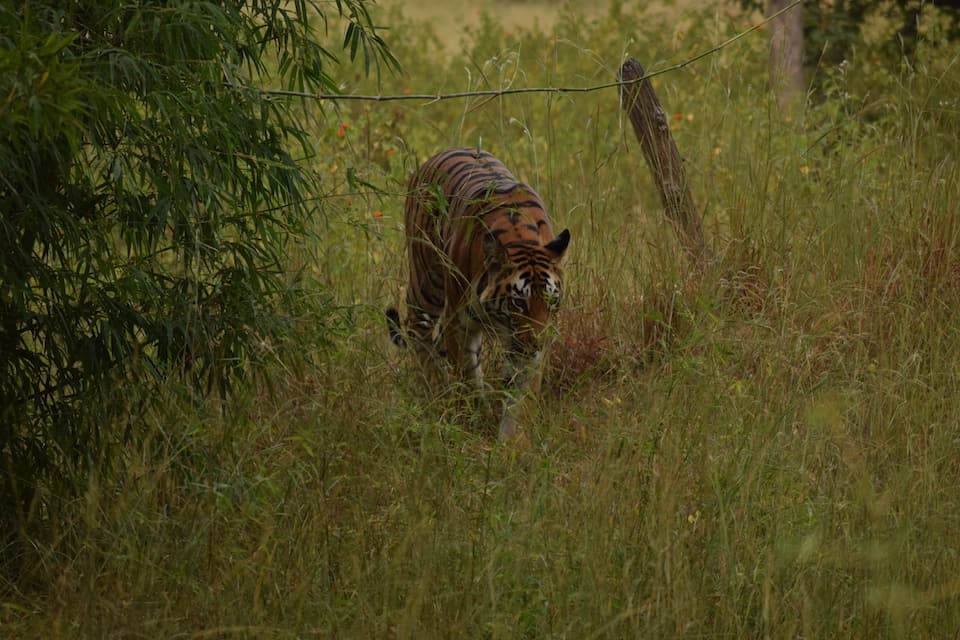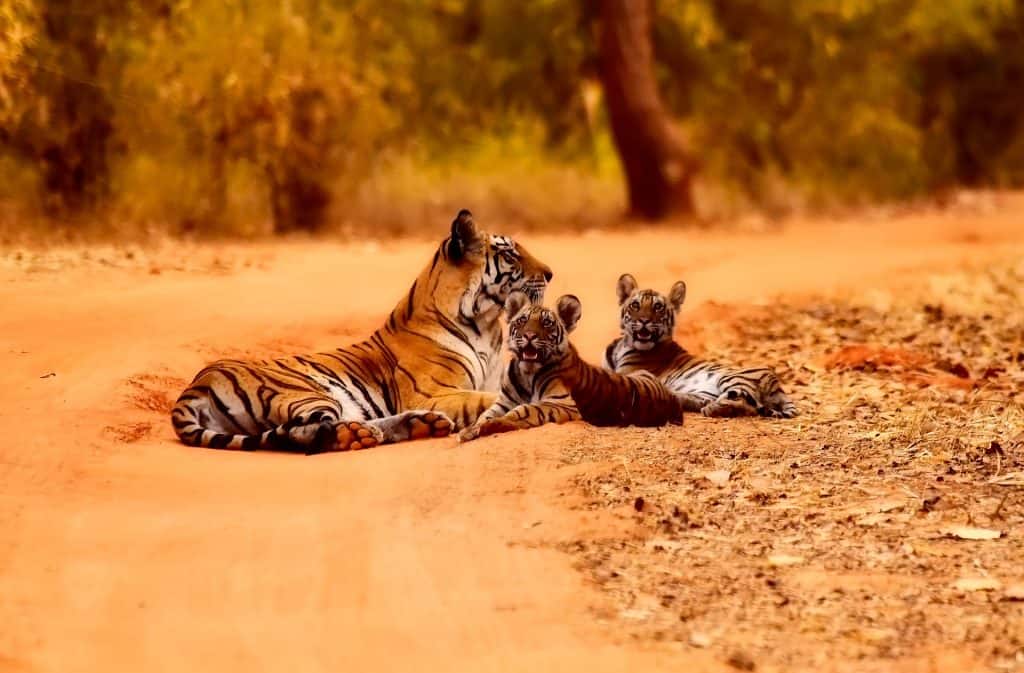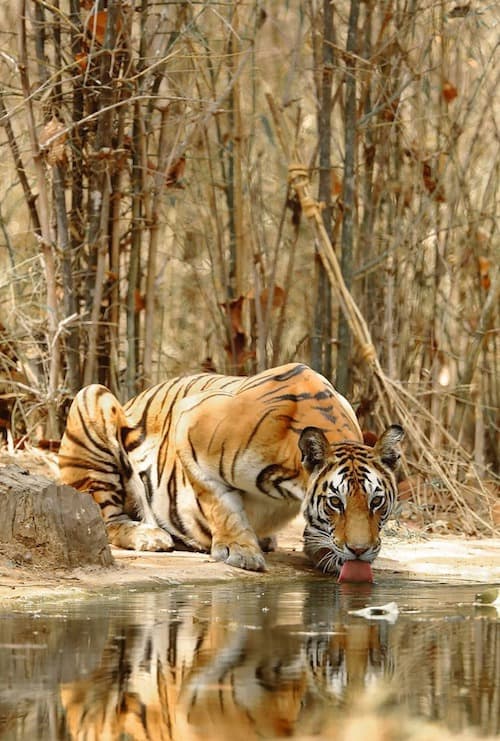This short guide to tiger safaris in India covers our top tips for seeing tigers in India, our recommended tiger parks, what you need to know about tiger safaris and much more!
Top Tips for Planning a Tiger Safari in India
Seeing a tiger in India in the wild is one of those experiences you do not want to miss, and many travellers dream of.
In 2015, I was one of them, and I was also one of the lucky ones. With only 2 days at Bandhavgarh National Park in Madhya Pradesh, my odds weren’t particularly high. But somehow my visualisation of seeing a tiger worked, and one crossed the road right in front of our jeep in the early morning sunlight.

Out of several hundred visitors to Bandhavgarh that morning, only our jeep and one other saw that same tiger. And that’s the beauty of tiger safaris in India: In many parks it’s beautifully old-school – drivers don’t radio each other, zones of parks are closed seasonally and the main navigational tool used to track down tigers is listening for alarm calls across the forest.
Meaning no crowds of jeeps around tigers, and a true sense of adventure.
Things have changed a bit since 2015. For India’s tiger population as well as for tiger safaris.
In this quick guide to safaris in India we’ll cover what you need to know about tiger-spotting in India, how to plan and book, and where our recommended places to go tiger-spotting are.
Tiger Conservation in India
Since my visit to Bandhavgarh in 2015, India’s tiger population has increased by a whopping 33%.
Clearly great news for a species that is still heavily endangered, India has been a success story in the focus on tiger conservation, and is now home to the vast majority of wild tigers around the world. The 2019 census of the tiger population showed fruits from the work of India’s “Project Tiger” as well as many passionate conservationists, responsible tourism initiatives, and individuals.
But the challenge remains for India’s tigers. Tigers are well known for requiring huge territories to roam in. Solitary creatures, each adult tiger requires a territory of around 200sq kilometres in order to live a healthy life. Some parks, such as Bandhavgarh are full to the brim, with simply not enough space for more tigers.
Although petitioners and campaigners have been calling for the creation of more “tiger corridors” which allow tigers the freedom to move between parks and roam wider terrain, there is a direct and sometimes literal competition for space between India’s tigers and its booming human population of over 1.2 million.
As populations and urban centres increase, tigers find themselves competing with humans for space. With tragic consequences for both humans and tigers.

Areas where tigers were free to roam even as recently as a few decades ago have been broken up, so that only small sections of land remain and tigers become isolated in their patch – unable to roam widely, come in contact with other tigers and therefore breed.
Often, the humans closest to the tigers are India’s poorest, reliant on land for farming and agriculture. When tigers stray and eat a few goats belonging to a farmer, things often don’t end well for the tiger. Just this year four men were arrested in Uttar Pradesh for beating a tiger to death.
If the mighty Bengal Tiger is to have a real hope of thriving in the future, we need to change the priority conservation is given vs the need for development.
The biggest threat facing tigers today is simply lack of space and human encroachment on their terrain.
What to Expect on a Tiger Safari in India
Firstly, tiger safaris never mean guaranteed sightings of tigers.
During my visit to Bandhavgarh, thanks to non-use of radios or tracking equipment, we were the lucky few to get a sighting that day.
In a national park covering over 1,530 sq kilometers, the roads are well spread out with dense grasslands and jungle in between, and drivers forbidden to drive off-road: All meaning reduced chances of seeing a tiger from afar or deep in the jungle or undergrowth.
And so we went about wildlife-spotting the old-fashioned way. Our naturalist and driver listening intently in the early morning air to the bird calls and noises of the jungle. Moments of silence punctuated by the rustling of animals in trees and their calls. They were listening for alarm calls—the calls that deer and other creatures let off when they see a predator such as a tiger to warn away other would-be-tiger-prey.
We spent what felt like hours sitting and listening.
Trying not to move and just to be silent.
Eventually we heard enough calls to pin down a location, and we saw the tiger initally in the distance, almost camouflaged in the long grass. Steadily she crept towards us before disappearing behind a thicket. There were two other jeeps nearby and the drivers started calling to each other, telling each other to move back. They predicted, correctly, that the tiger was about to cross the road in front of us, so we should make space for her. She crossed not more than a few paces in front of us.
Seeing wildlife in a relatively free habitat walk that close in front of you is what I can only describe a humbling experience.
For those moments, I felt entirely present—nothing else mattered, I was just in awe of this stunningly beautiful and fearsome creature who looked at us as if to say “oh, you lot again” before going about her business.
READ MORE: 23 of the Best Eco Lodges in India

Tips for Seeing Tigers in India
Now that we’ve established that seeing tigers is on the tigers’ terms, not ours, here are a few of our tips for increasing your odds with tiger spotting in India:
- Take the early morning drives. This is when your chances of seeing a tiger are highest (means getting up early – but it’s worth it!)
- Take a jeep (often referred to as a “Gypsy”) and not a canter/bus. Jeeps are smaller, more intimate, quieter and can go along smaller tracks – all meaning a better safari experience that causes less disturbance for the tigers. Views in the canters can be restricted and they can be noisy.
- Be QUIET. A tiger is not going to show up if it can hear people talking.
- Avoid wearing bright colours, perfumes, and do not smoke (the tiger will smell your smoke a mile away and change direction). Flash photography is also prohibited.
- If you can bear the heat, visit tiger reserves in April / May. As the summer is hot and water is scarce, tigers and other wildlife congregate around watering holes, thereby increasing viewing chances. Plus, there are fewer tourists and lodge prices are reduced.
- Stay a few days. To really get the best of the forest experience, it’s helpful to stay 2-3 nights or more so that you can go on plenty of safaris and enjoy being in India’s beautiful nature.
- Please respect the environment and do not use plastic, including single-use water bottles, or leave anything behind you. You don’t want a tiger dying from eating your plastic water bottle! (Tips on how to avoid plastic water bottles here)
- Many parks close between June – mid October for the monsoon, or only have restricted zones open during those months.
How to Plan & Book Tiger Safaris in India
Given the popularity of tiger safaris in India, you need to book your accommodation and safaris well in advance. Ideally, you want to book several months out (4-6 months, or as soon as you know your itinerary).
All tiger reserves and national parks in India have daily quotas of visitors that are allowed in; if you don’t get there in time, you may miss out.
Some parks have a number of different zones, some are thought to be “better” (or less busy) than others. We suggest reading up in detail on the National Park you plan to visit to find out if you want to visit a specific zone. With other parks, it’s just luck of the draw on the day.
There are two ways of booking safaris in India:
- Through your resort or accommodation
- Or direct through the state’s Forestry Department website. You need to register first. You can find the websites here for Rajasthan here for Madhya Pradesh . Karnataka is planning an app/website for safari booking soon, at present safaris need to be booked via resorts.
- Rajasthan and Madhya Pradesh both have a ‘Tatkal” option (just like Indian Railways!) where last minute safaris can be bought, at an extra cost.
- Any other websites other than official Forestry Department ones which end with .gov.in are all just travel agencies, selling marked up safaris – we don’t recommend these.

Our Favourite Tiger Reserves for Safaris in India
Madhya Pradesh has the greatest number of tiger parks in India and is the original “Jungle Book” landscape. Many people come here, and it’s one of the best areas to see tigers in India, but it’s also one of the most popular, meaning it gets booked up and busy during peak season (Nov-Feb).
In no particular order, here are some of the parks that get the best reviews / we recommend:
- Bandhavgarh, Madhya Pradesh (from personal experience) – this is a beautiful park, but book well ahead. Stay at the Treehouse Hideaway Resort if you can for extra wow factor!
- Kanha, Madhya Pradesh – Many peoples’ favourite tiger reserve in India, Kanha is the original inspiration for the Jungle Book. Staying at Kanha Earth Lodge is highly recommended.
- Sariska, Rajasthan – A great alternative to the overcrowded Ranthambhore. A number of tigers have recently been relocated to Sariska from Ranthambhore, and the park needs support. Stay at the Utsav Camp Sariska.
- Nagarhole & Bandipur Tiger Reserves, Karnataka – Visited by few compared to the northern parks, Nagarhole and Bandipur are both part of the Nilgri Biosphere Reserve in southern India and are one of the most beautiful places to spot tigers. Stay at Red Earth Kabini.
- Jim Corbett Tiger Reserve, Uttarakhand – Covering over 1318 sq km of wild forests, this was India’s very first national park. A few zones of the park are open throughout monsoon. Stay at the Vanghat Jungle Lodge.
READ MORE: What to pack for your trip to India

The Future for Tigers in India
Several projects are underway to restore tiger corridors—the opening up of much larger sections of protected land that flow into each other—to avoid the permanent extinction of this wonderful animal.
Something that will stay with me from my experience in Bandhavgarh four years ago was the reaction of some of the other jeeps that were lucky enough to see the tiger that day. Instead of being delighted at seeing the tigress, their immediate demand was: “Ok now find us the father and the cubs”.
Really?
Can it really be that we have become so used to being entertained that we view wildlife as simply an entertainment—where national parks become zoos—and those working in the parks as guides feel compelled to serve up the perfect sighting to their tourist customers.
It makes me realise that actually, not seeing a tiger is not necessarily the worst thing. Far from meaning that they have become extinct, it could be a future indicator that their room to roam has grown again, and that, as they had done for centuries before, that they can live undisturbed away from humans.
And how can we help? We can help by always respecting wildlife, only attempting to see wildlife from safaris at a distance and by truly appreciating nature. We can make sure we never support activities that allow us to interact with wildlife (riding, cuddling, taking selfies) or anything that interferes with an animal. We can also help by going to less visited national parks and staying at environmentally friendly lodges (like the ones listed above) whenever we can.